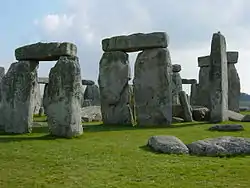Wiltshire Museum
The Wiltshire Museum, formerly known as Wiltshire Heritage Museum and Devizes Museum, is a museum, archive and library and art gallery in Devizes, Wiltshire, England. The museum was established and is still run by, the Wiltshire Archaeological and Natural History Society (WANHS), a registered charity founded in 1853. After the purchase of an old grammar school the museum was opened in 1873. Subsequently, it expanded into two Georgian houses on either side and still occupies this location today.[1]
 | |

| |
| Established | 1873 |
|---|---|
| Location | Long Street, Devizes, Wiltshire, England |
| Type | Archaeology Museum, History museum |
| Director | David Dawson |
| Curator | Lisa Brown |
| Website | www |
The museum maintains a collection covering the archaeology, art, history and natural history of Wiltshire. This collection covers periods of history from as far back as the Palaeolithic and also includes Neolithic, Bronze Age, Roman, Saxon, Mediaeval and more recent historical artefacts.[2] Among the prehistoric collections are items from the Stonehenge and Avebury World Heritage Site.[3] Several of the collections have been designated as being a significant part of England’s cultural heritage.[3]
One of the most important collections at the museum is the finds from Bush Barrow, an early Bronze Age burial mound in Stonehenge World Heritage Site. The barrow was excavated by William Cunnington in 1808 and produced the richest and most important finds from a Bronze Age grave in the Stonehenge Landscape to date. The finds were acquired by the museum in 1883 and were displayed there until 1922 when they were indefinitely loaned to the British Museum. After a controversial restoration of the largest piece that may not reflect its original finish, the pieces were returned to Devizes in 1985.[4] They are on display in the Gold from the Time of Stonehenge exhibition, opened in 2013.[5]
The natural history collection includes remains of a plesiosaur called Bathyspondylus found at Swindon in 1774. Bathyspondylus swindoniensis was first described in 1982 from the Museum's specimens.[6]
In 2010 the Museum ran a community bus service, the "Henge Hopper", linking Avebury with Amesbury and Stonehenge.[7][8]
References
- "About Wiltshire Museum". Wiltshire Archaeological and Natural History Society. Retrieved 26 August 2015.
- Crooks, Jill (23 March 2009). "Wiltshire museum bids to shed stuffy image". This is Wiltshire. Retrieved 20 October 2015.
- "Designated Collections 2008" (PDF) (Press release). The Museums, Libraries and Archives Council. July 2008. Retrieved 2008-10-22.
- Caple, Chris (2000). Conservation Skills: Judgement, Method and Decision Making. Routledge. ISBN 0415188814.
- "Stonehenge period gold on display at Wiltshire Heritage Museum". BBC News. 14 October 2013. Retrieved 20 October 2015.
- "Plesiosauria Translation and Pronunciation Guide at dinosauria.com". Retrieved 29 October 2009.
- "Bus from Avebury to Devizes circles historic sites". Gazette & Herald. Marlborough. 5 May 2011. Retrieved 20 October 2015.
- "Henge Hopper – the Stonehenge Avebury Bus | Linking the Great Stones".

